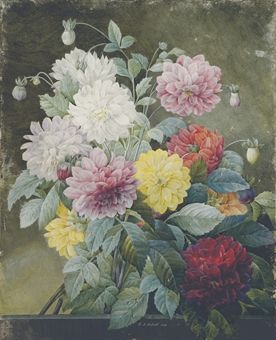Pierre-Joseph Redouté (Saint-Hubert 1759-1840 Paris) - A bouquet of Dahlias (Dahlia variabilis)
Pierre-Joseph Redouté (Saint-Hubert 1759-1840 Paris) - A bouquet of Dahlias (Dahlia variabilis)
signed 'P.J Redouté 1834.' black lead, watercolour, heightened with bodycolour and gum arabic, on vellum 27½ x 22 in. (698 x 560 mm.) - Estimate : £120,000 - £180,000 ($237,960 - $356,940)
FROM A ROYAL FAMILY ESTATE (LOT 138)
Notes : The most celebrated botanical artist of his day, Pierre-Joseph Redouté was the son of Charles-Joseph, a successful decorator, and one of three brothers, all of whom became artists. At the age of thirteen he left home to study in Liège and over the next few years travelled through Luxembourg, Flanders and Holland. Here he encountered the works of the great Dutch and Flemish flower painters of the 17th and 18th Centuries, including Jan van Huysum, Daniel Seghers, Rachel Ruysch and Gerard van Spaëndonck, strong influences on his style.
In 1782 he joined his elder brother Antoine-Ferdinand who was designing stage scenery in Paris. Together they worked on the new Théâtre Italien in the rue de Louvois with Redouté spending any spare time dedicated to painting flowers. His search for rare specimens took him to the Jardin du Roi where he spent many hours studying. It was here that he came to the attention of the wealthy amateur botanist Charles-Louis L'Héritier de Brutelle, the first of what was to become a long and illustrious list of patrons. More than fifty of the plates in L'Héritier's Stirpes Novae (1784-85) are engraved after drawings by Redouté, and when L'Héritier visited London in 1786, Pierre-Joseph travelled with him and collaborated on his Sertum Anglicum (1788), a study of the rare plants growing at Kew. Most likely on L'Héritier's recommendation Redouté was appointed Draughtsman to the cabinet of Marie-Antoinette. The Queen showed little interest in painting, but it is said that during her weeks of imprisonment she sent for Redouté to paint a cactus which had particularly taken her fancy (W. Blunt and W.T. Stearn, The Art of Botanical Illustration, London, 1967, p. 196).
During the First Empire Redouté found an enthusiastic and generous patroness in Joséphine Bonaparte who purchased and cultivated rare plants for her gardens at Malmaison. Several magnificent folios illustrated with coloured engravings after Redouté's drawings were published by the botanist Ventenat to record her collection and a bound volume of drawings for the engraved plates of one such album, Les Liliacées, published in 80 instalments between 1802-26, was sold at Sotheby's, New York, 20 November 1985.
Josephine's death in 1814 saw Redouté's vast illustrative projects come to an end. He then returned to the larger more complex compositions that had been the mainstay of his earlier career.
This impressive drawing, dated 1834, is on the same grand scale as the watercolour Offrande à Bacchus exhibited by the artist at the Paris Salon of the same year under the denomination 'Tableaux à l'aquarelle' (The Floral Art of Pierre-Joseph Redouté, exhib. cat., Greenwich, Bruce Museum of Arts, 2002, fig. 20). The use of watercolour applied with extreme subtlety and the lightest touch of bodycolour to indicate the fine sheen of the petals, demonstrate perfectly Redouté's delicacy of handling and technique.
Christie's. 8 July 2008 OLD MASTER AND 19TH CENTURY DRAWINGS

/https%3A%2F%2Fprofilepics.canalblog.com%2Fprofilepics%2F1%2F0%2F100183.jpg)
/https%3A%2F%2Fstorage.canalblog.com%2F03%2F02%2F119589%2F96711876_o.jpg)
/https%3A%2F%2Fstorage.canalblog.com%2F11%2F31%2F119589%2F94773502_o.jpg)
/https%3A%2F%2Fstorage.canalblog.com%2F20%2F83%2F119589%2F94772815_o.jpg)
/https%3A%2F%2Fstorage.canalblog.com%2F26%2F72%2F119589%2F75604929_o.jpg)
/https%3A%2F%2Fstorage.canalblog.com%2F59%2F60%2F119589%2F26458628_o.jpg)



/image%2F1371349%2F20240425%2Fob_c453b7_439605604-1657274835042529-47869416345.jpg)
/image%2F1371349%2F20240425%2Fob_59c6f0_440358655-1657722021664477-71089985267.jpg)
/image%2F1371349%2F20240425%2Fob_07a28e_440353390-1657720444997968-29046181244.jpg)
/image%2F1371349%2F20240425%2Fob_0b83fb_440387817-1657715464998466-20094023921.jpg)